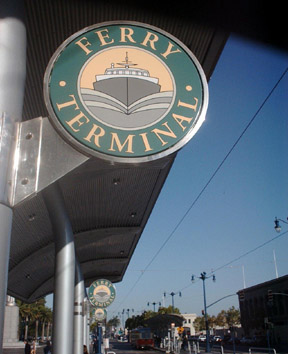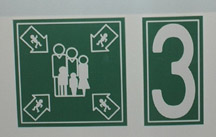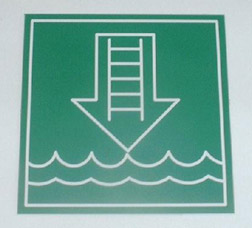 |
| Ferry
Terminal Sign at Harry Bridges Plaza |
Signs of the Times
By Guy Span, S.D.
With the new economy steaming right down the
toilet and the old one looking a little down at the heels, we have
to look elsewhere for signs of a recovery. And where else to look,
but in San Francisco, where there are plenty of signs of life. For
the sign makers, that is. Newly arrived at the south end of the
Ferry Building, we find a brand new sign telling us, as we stand
in the shadow of Ferry Building’s trademark clock tower, that we
are at 1 Ferry Plaza. This incredibly useful and informative sign
also sports a compass, perhaps relating to the World Trade Club
which relocated to the former Gabbiano’s, just above the BART
ventilation tubes. But it doesn’t say so.
This new arrival raises the question of just
where the Ferry Plaza is located (and guess what? It’s not where
the sign is.). New signs in the area and colorful, illuminated
maps depict the Ferry Plaza as the space behind the Ferry
Building, where one boards the Golden Gate Ferry. These same new,
useful and up-to-date signs show direct service to Angel Island
from Vallejo and direct ferry service to the preserved aircraft
carrier, the Hornet over in Alameda. This awarded the island city
the triple crown for ferry services (although, in reality the
three different services quickly reduced to two as ferry service
to the Hornet ceased over two years ago).
So, if the home to the statue of the celebrity
ferry supporter, Mahatma Gandhi and the unattractive staging area
for the Golden Gate Ferry is the Ferry Plaza and is behind the
Ferry Building, what is the name of the cold and sterile plaza in
FRONT of the Ferry Building? Well, consulting the same maps near
“Gate E”, we find that the plaza in front is named after the
famous longshoreman labor leader, Harry Bridges.
But is there a sign in the plaza to tell you
this? Nope. The only signs are at the unattractive streetcar stops
and they advise that this stop is the “Ferry Terminal.” For
some reason, the stop couldn’t be known as what everyone calls
it: the Ferry Building.
 |
| The Sign
for 1 Ferry Plaza located on Herb Caen Way sidewalk, AKA
the Embarcaderro. |
But interestingly enough, the Ferry Building
wasn’t always known by that name. When built, it was known as
the Union Ferry Depot, where most ferry lines to San Francisco
landed. It kept that name until some time after the Pan Pacific
Exposition in 1915, when the name Ferry Building came into more
general usage. By 1923, according to old post cards, everyone was
calling it the Ferry Building.
But our sign meisters, whoever they are, have
decided to completely discard eighty years of history and give the
area yet another name. And as a result, we find loads of “Ferry
Terminal” signs, just about everywhere except in the Ferry
Plaza. Surprisingly enough, the Ferry Plaza is the only place,
according to a different sign, where there
actually was a ferry terminal. Golden Gate bestowed this name and
thus we find the “Stephen Leonoudakis Ferry Terminal” at the
Ferry Plaza. But don’t look for the other “Ferry Terminal”
signs in this plaza.
These ubiquitous terminal signs depict a
stylized single-hull ferry whooshing at speed across the Bay and
are located all over the Harry Bridges Plaza and at two of the
three landings. So who would suspect that the Ferry Building (a
logo unto itself) would need a new logo? Only the sign meisters
who, just for the anarchy of it, left us with the organized
landings called “Gate B” (Vallejo, Tiburon), the “Stephen
Leonoudakis Ferry Terminal” (Sausalito, Larkspur) and “Gate E”
(Alameda – Oakland, Harbor Bay).
 |
| The riders
believe this one means, “In the event of danger,
collision, damage or all three, run to your mother and
father.” |
And out in front of the Ferry Building (when
will it get a sign?) there is a temporary wall with old photos and
a bit of heavily sanitized history. The one covering the most
recent era advises that the Loma Prieta earthquake occurred on
October 19, 1989 (although some outraged local used a black marker
to make a correction to the 17th). That same sign also advises
that the Embarcadero Freeway was torn down in 1990, a surprise to
all of us who, in the rain, watched Mayor Agnos at the
commencement of the demolition on February
27, 1991.
Another sign in the same group advises that in
the heyday of ferries in 1920, some 22,657,418 persons were
carried into the ferry terminal. It’s a very specific number of
people. It sounds correct. But it’s not. That oft-repeated
number comes from a 1958 promotional handout that Southern Pacific
created for the last run of the last surviving ferry line. The
fact is, that was the number of people carried by SP in 1920. That
same year, the Monticello Steamship Company, the Santa Fe Railway,
Western Pacific Railway and the Key Route also served the Ferry
Building. And they had riders, too.
But San Francisco is not alone in its bizarre
and inaccurate signs. Excellent company is found on board the
plucky little Alameda Oakland Ferryboat, the Peralta. The Peralta
was named after the ill-starred Key Route ferry, which caused the
largest number of deaths in a ferry accident on San Francisco Bay
and later, perhaps to hide her shame, lost most of her
superstructure to a fire at the Key System Mole. But ours (which
will hopefully fare better) is loaded with modern signage, which
in sort of reverse McCluen speak is apparently designed to mystify
the message.
 |
| Ladders
are found under water |
Topside, on the back deck, there is a pictograph
which shows a mother and father and three children in the center,
with what appears to be a running child in each of the four
corners. Oddly enough, the number 3 appears along side of it.
Ferry riders have been puzzling out the meaning of this for quite
some time and have concluded that it says: “In event of damage,
collision, danger or all three, run to your mother and father.”
Always sage advice.
Also on the back deck, there is another
pictograph that appears to be a Mexican Sombrero floating in the
water. It is located next to the ladder that accesses the topside
of the ferry. The translation? “In the event of a threatened
sinking, climb the ladder and put on the Mexican Thinking Hat…”
The short version is “Don’t panic!.”
Dropping down to the main deck, port side, there
appears a picture of a ladder, water and an arrow pointing down.
The riders are more confident of this one: “Ladders are found
under water.” And finally, just for the sheer randomness of it
all, evacuation instructions for this ferry are found in English
and French. Although the French instructions are probably less
comforting, as they begin, “To Evacuate the Building…”
 |
| Riders
have translated the floating sombrero as, “Don’t
panic!” |
Hayward also has an offering, once nominated by
Herb Caen for the “Least Informative Road Sign in America.”
That sign lets you know that the next exit is: “A Street
Downtown.” Entering the Bay Bridge from San Francisco, we still
find signs that say “Toll Crossing Direction.” Even the
Embarcadero (the street with the least signs telling you its name)
is not immune. There are signs that call it “Herb Caen Way (but
this is supposed to refer to the sidewalk only) and also signs
that call it Route 5, which is apparently some sort of bicycle
designation, but don’t look for it on a map.
Signs used to be simple declarative statements, offering sensible
advice or providing useful information; sometimes just a place
name, so you would know where you are. Our own Bay Bridge is home
to what has to be the oldest road sign in America still in use on
the Interstate Highway system (this one needs a historical
marker!). It offers advice in rusting porcelain enamel, while
reminding us the bridge is now very different from when it opened
in 1937.
Located on the right hand side of the top deck,
midway in the first span from Treasure Island is a sign that says,
“No Stopping or Turning on Bridge.” It takes us back to the
days when both decks were bi-directional and electric trains ran
on the lower one.
So were the times really simpler back then?
There are signs that seem to indicate that they
were.
Note: The correct Peralta sign translations are
found in tiny print on an architectural drawing, located on the
main deck. The family sign means “Muster Station,“ where you
report in the event of emergency (there are three stations on
board). The Sombrero indicates the location of a life raft and a
ladder is located in the bench under the arrow and is used for man
overboard situations. Just in case you needed to know.